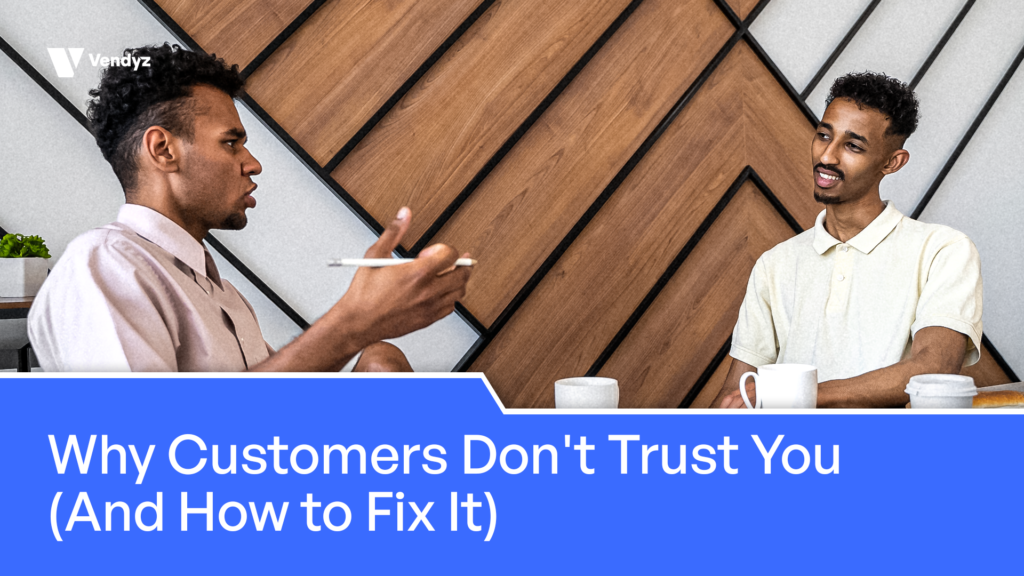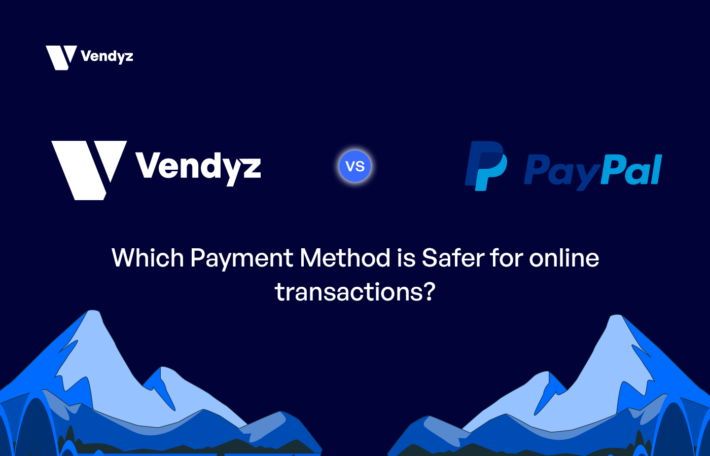Why Customers Don’t Trust You (And How to Fix It)

Why Customers Don’t Trust You (And How to Fix It)
The currency of success isn’t just your product quality or pricing strategy; it is about trust, and if your customers don’t trust you, you should be worried. According to recent studies, 81% of consumers say they need to trust a brand before making a purchase decision. Unfortunately, most online vendors struggle to establish this crucial foundation. This comprehensive guide reveals five proven trust-building methods that have transformed skeptical shoppers into loyal customers.
The Trust Crisis in Online Commerce
The statistics paint a sobering picture: 54% of consumers don’t trust the brands they buy from as much as they did in the past. In an era where online scams cost consumers billions annually, your potential customers approach every transaction with heightened skepticism. This trust deficit isn’t just a perception problem, it directly impacts your bottom line, with studies showing that trusted brands outperform competitors by up to 3x in sales growth.
What’s causing this trust gap? Research points to several key factors:
– Previous negative experiences with online purchases
– Media coverage of e-commerce fraud and scams
(see, for example, insights from Adobe’s Future of Marketing Research)
– Inconsistent communication from vendors
– Lack of transparency in pricing and policies
– Unclear payment security measures
Before potential customers even consider your product quality or service value, they’re asking one fundamental question: “Can I trust this business?” Your ability to answer this question affirmatively determines whether they’ll continue down your sales funnel or abandon it entirely.
Method 1: Transparency and Clear Communication

Price Transparency: The End of “DM for Price”
The practice of asking potential buyers to “DM for price” creates an immediate trust barrier. This outdated approach signals to customers that you might be hiding something or manipulating prices based on what you think they’ll pay. Clear, upfront pricing eliminates this friction point and filters out window shoppers, allowing you to focus on serious prospects.
Consider implementing:
– Transparent pricing tables with all options clearly displayed
– “No hidden fees” guarantees prominently featured
– Price comparison tools that show your value proposition
Refund Policies That Build Confidence
A “no refunds” policy is a major red flag for potential customers. Data from the National Retail Federation shows that 67% of shoppers check return policies before making a purchase. Rather than eliminating refunds, create reasonable guidelines that protect both parties:
– 30-day satisfaction guarantees (reducing perceived risk)
– Clear criteria for refund eligibility
– Simple, documented return processes
Proactive Problem-Solving
The most effective trust-building approach anticipates customer concerns before they arise. When a clothing retailer changed their sizing guidance from a simple “check our size chart” to “Still unsure? Watch this video on how to find your perfect size,” they saw a remarkable 20% increase in sales conversions. This proactive approach positions you as an expert who understands customer concerns.
Method 2: Customer Testimonials and Social Proof

Nothing builds trust more effectively than hearing from satisfied customers. According to BrightLocal, 87% of consumers read online reviews for local businesses, and 79% trust online reviews as much as personal recommendations.
Strategic Testimonial Collection
Don’t wait for reviews to appear organically. Implement a systematic approach:
– Send follow-up emails requesting feedback 3-5 days after purchase
– Create incentives for video testimonials (which convert 64% better than text)
– Use platforms like Trustpilot to collect and display verified reviews
User-Generated Content Strategy
Unfiltered content from real users offers authenticity that branded content can’t match. Consider:
– Creating hashtag campaigns encouraging customers to share their experiences
– Partnering with micro-influencers for honest product reviews
– Featuring customer photos and stories in your marketing materials
Handling Negative Reviews
The counterintuitive truth about negative reviews: they can actually build trust when handled correctly. Research from the Harvard Business Review shows that products with some negative reviews are perceived as more trustworthy than those with perfect ratings.
When you receive critical feedback:
– Acknowledge the issue publicly and apologize when appropriate
– Explain how you’re addressing the concern
– Offer a solution to the specific customer
– Follow up to ensure satisfaction
This transparent approach signals to potential customers that you value feedback and stand behind your products.
Method 3: Risk-Free Payment Options with Escrow Services

Payment security represents one of the most significant trust barriers in e-commerce. According to the Baymard Institute, 17% of cart abandonments occur due to payment security concerns.
The Power of Escrow Services
Escrow services have emerged as a powerful trust-building mechanism, particularly for high-value transactions. Platforms like Vendyz have revolutionized this space by creating a safety net that protects both buyers and sellers from financial loss and product theft.
The escrow process is elegantly simple yet incredibly effective:
- Buyer deposits payment with a secure third-party service
- Seller is notified and ships the product
- Buyer receives and approves the product
- Escrow service releases payment to the seller
This process eliminates the primary fear for both parties: buyers worry about paying and not receiving the product, while sellers worry about shipping and not getting paid.
Implementing Escrow Solutions for Your Business
Modern escrow solutions have made implementation surprisingly straightforward. For example, Vendyz offers a streamlined process that works across multiple platforms, allowing you to:
– Create payment links in seconds
– Process transactions with top-tier security protocols
– Provide buyers with verification and protection
– Access built-in tools for dispute resolution if needed
The most forward-thinking vendors are finding that implementing escrow options actually increases conversion rates by addressing trust concerns upfront. According to recent case studies, vendors offering escrow payment options through platforms like Vendyz has seen conversion rate increases of up to 25% for transactions exceeding ₦500,000.
Beyond Basic Escrow: Additional Payment Security Measures
While escrow services provide maximum protection, you can further build payment trust through:
– Implementing secure payment processing with Stripe or PayPal
– Offering buyer protection guarantees
– Providing detailed tracking information
– Creating milestone-based payment structures for services
Method 4: Building Long-Term Customer Relationships

Customer acquisition costs have increased by over 60% in the past five years. This makes retention not just a trust strategy but a profitability imperative. According to Harvard Business School, increasing customer retention by just 5% can boost profits by 25-95%.
Post-Purchase Communication Strategy
The period immediately following a purchase represents a critical trust-building opportunity:
– Send immediate purchase confirmation with clear next steps
– Provide shipping updates at each stage of fulfillment
– Follow up 3-5 days after delivery to ensure satisfaction
– Request feedback and reviews after the customer has had time to use the product
Personalized Engagement Campaigns
Generic marketing messages undermine trust. McKinsey research shows that 71% of consumers expect personalized interactions, and 76% become frustrated when this doesn’t happen.
Implement personalization through:
– Product recommendations based on purchase history
– Exclusive early-access opportunities for loyal customers
– Personalized content that addresses their specific needs
– Special occasion recognition (birthdays, anniversaries)
Loyalty Incentives That Drive Retention
Strategic loyalty programs create anticipation and encourage repeat purchases. Successful approaches include:
– Tiered reward structures that increase with purchase frequency
– Point systems with clear redemption options
– Surprise rewards that create delight and shareability
– Exclusive community access for repeat customers
Some innovative vendors are even leveraging secure payment platforms like Vendyz to create loyalty programs that reward customers for using secure payment methods, creating a virtuous cycle of trust and repeat business.
Method 5: Consistency and Responsive Customer Support

Inconsistency creates doubt. Customers need to know they can count on you to deliver the same quality experience every time. According to Salesforce research, 76% of customers expect consistent interactions across departments.
Response Time Expectations
In today’s immediate gratification economy, slow responses signal indifference. Aim for:
– Email responses within 4 hours during business hours
– Social media responses within 60 minutes
– 24/7 automation for frequently asked questions
Setting Clear Customer Service Parameters
When perfect responsiveness isn’t possible, clear communication prevents disappointment:
– Prominently display business hours
– Use autoresponders with expected response times
– Provide alternative contact methods for urgent issues
– Consider implementing Zendesk or similar platforms to manage support tickets
Consistency in Brand Voice and Experience
Customers notice when your communication style suddenly shifts or when policies change without explanation. Maintain consistency through:
– Documented brand voice guidelines for all team members
– Centralized policy documentation
– Regular training for customer-facing staff
– Advance notice for any necessary changes
Measuring Trust Improvements
Trust building isn’t just a philosophical approach, it’s a measurable business strategy with concrete ROI. To track your progress:
Key Trust Metrics to Monitor
– Net Promoter Score (NPS) improvements
– Review sentiment analysis trends
– Cart abandonment rate changes
– Average order value increases
– Customer lifetime value growth
– Second purchase likelihood increases
Creating a Trust Dashboard
Implement a simple dashboard using Google Data Studio or similar tools to visualize your trust metrics over time. This allows you to identify which strategies are delivering the greatest impact and adjust accordingly.
Case Study: Building Trust Through Modern Escrow Implementation
A mid-sized electronics reseller in Lagos was struggling with customer hesitation on high-value items. After researching various solutions, they implemented Vendyz as their escrow provider for transactions over ₦300,000. The results were remarkable:
– 27% increase in conversion rate for premium products
– 35% reduction in customer service inquiries about payment security
– 19% increase in average order value
– Significant competitive differentiation in their market segment
What made this implementation particularly effective was how seamlessly it integrated into their existing sales process. Rather than disrupting their workflow, the escrow solution enhanced it, providing both them and their customers with peace of mind.
Conclusion: The Compound Interest of Trust
Building customer trust isn’t a one-time event but an ongoing investment that pays compound interest. Each positive interaction, transparent communication, and secure transaction builds upon the last, creating a foundation of trust that becomes your most valuable business asset.
Start by implementing these five proven methods:
- Embrace radical transparency in all communications
- Systematically collect and showcase customer testimonials
- Offer risk-free payment options through escrow services
- Build personalized, long-term customer relationships
- Maintain consistent, responsive customer support
In an era where online fraud is increasingly sophisticated, taking proactive steps to build trust isn’t optional, it’s essential. Forward-thinking vendors are discovering that by implementing solutions like secure escrow services, they’re not just preventing problems but actively building customer confidence and loyalty that translates directly to increased sales.
Remember that building trust is only the first step in increasing sales. There are many other strategies to explore. Join our WhatsApp community today to unlock exclusive updates on growing your e-commerce business and implementing advanced trust-building techniques.



